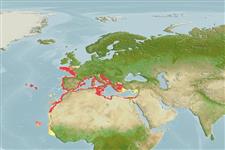Common names from other countries
Classification / Names / Names
Common names | Synonyms | Catalog of Fishes (gen., sp.) | ITIS | CoL | WoRMS
Environment: milieu / climate zone / depth range / distribution range
Ecology
Benthic; depth range 0 - 200 m (Ref. 2754). Subtropical, preferred 19°C (Ref. 107945); 50°N - 9°N, 32°W - 36°E (Ref. 99669)
Eastern Atlantic and the Mediterranean: North to the Channel Islands, south to Guinea, including Azores, Canary and Cape Verde Islands, and east to the Mediterranean. Introduced in Ireland and Gulf of Aqaba, Red Sea in Israel.
Length at first maturity / Size / Weight / Age
Maturity: Lm 4.9, range 4 - 5.4 cm Max length : 12.3 cm SHL male/unsexed; (Ref. 99669); common length : 8.0 cm SHL male/unsexed; (Ref. 438); max. reported age: 15 years (Ref. 99669)
Collected from the sublittoral zone, from low tide up to a depth of 200 m (Ref. 2754).
Life cycle and mating behavior
Maturity | Reproduction | Spawning | Eggs | Fecundity | Larvae
Gonochoric; broadcast spawners (males release first before the females). Spawning occurs from spring to late autumn.
Demir, M. 2003. (Ref. 2754)
IUCN Red List Status (Ref. 130435: Version 2024-1)
CITES status (Ref. 108899)
Not Evaluated
Not Evaluated
Human uses
Fisheries: commercial
FAO - Aquaculture: production; Fisheries: landings | FishSource | Sea Around Us
Tools
Internet sources
Estimates based on models
Preferred temperature
(Ref.
115969): 7 - 18.6, mean 10.5 (based on 572 cells).
Resilience
High, minimum population doubling time less than 15 months (K=0.27-0.4; tm=3; tmax=15).
Vulnerability
Moderate vulnerability (39 of 100).
